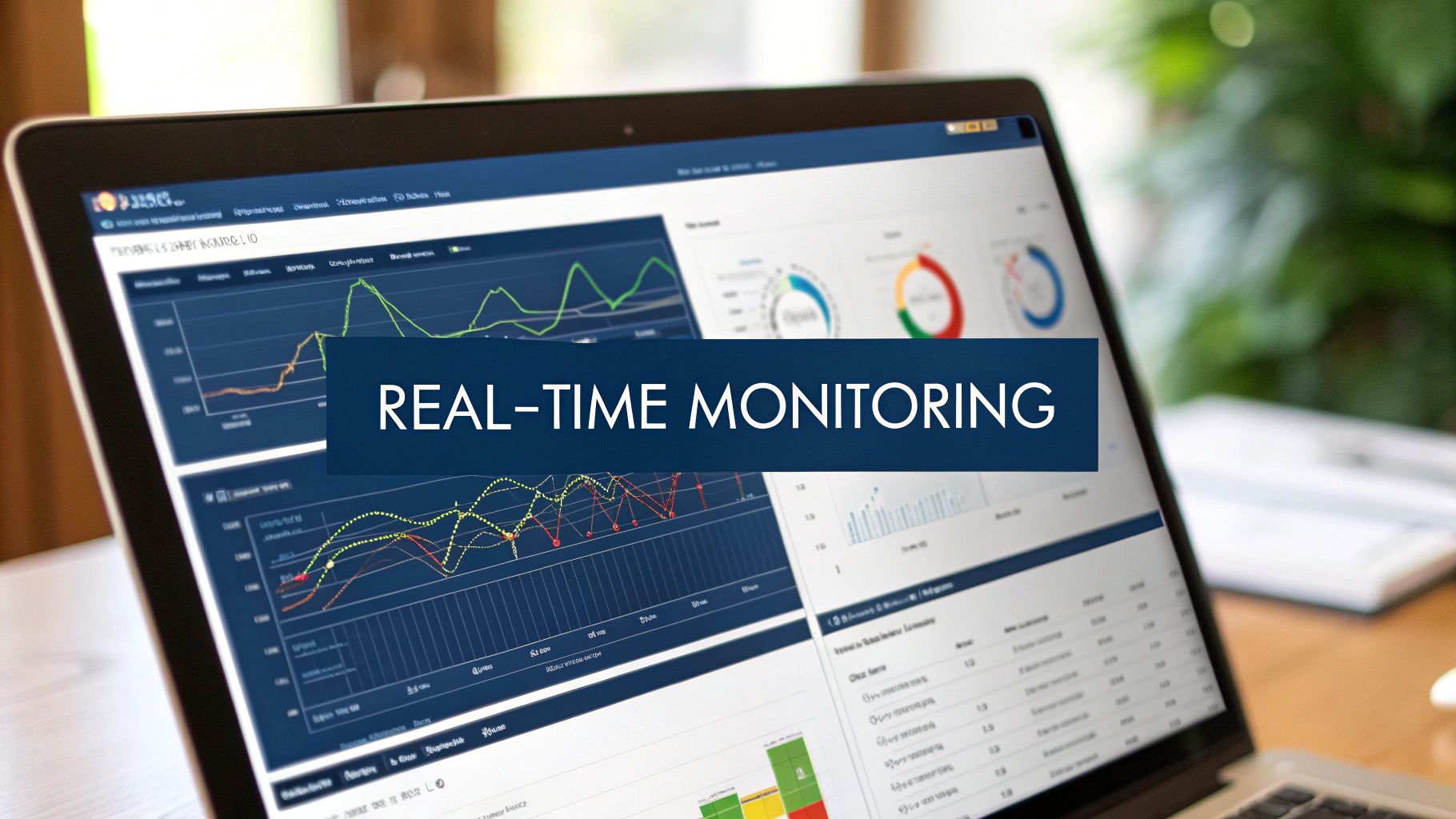The Ultimate Guide to Compliance Management Solutions: Transform Your Regulatory Strategy
Understanding Modern Compliance Management Solutions

Managing compliance has changed fundamentally in recent years. Organizations now need to do more than just follow rules - they must actively prevent problems and build a culture of ethical behavior. This need has grown as regulations become more complex and businesses recognize compliance as essential to their strategy and success.
The old ways of handling compliance through manual processes and scattered spreadsheets often led to mistakes and inefficiency. Modern compliance solutions have transformed this by bringing everything together in one place, automating routine tasks, and providing real-time insights. This lets compliance teams focus on preventing issues rather than just reacting to problems after they occur. Companies can spot potential concerns early and address them before they escalate.
Key Components of Modern Compliance Management Solutions
A strong compliance system brings together several essential parts that work as one unified whole:
- Risk Assessment Tools: Help find, analyze and rank potential compliance risks
- Automated Compliance Tracking: Reduces manual work and human error by automating tracking tasks
- Centralized Documentation: Keeps all compliance materials in one easy-to-access location so everyone uses current information
- Real-Time Reporting and Analytics: Provides instant insights into compliance performance for better decisions
- Regulatory Change Management: Automatically updates and alerts teams about new regulations to maintain compliance
These capabilities allow organizations to adapt their compliance as they grow and regulations evolve. This flexibility is crucial as business conditions continue to change. The growing demand for these solutions shows their increasing value - the market reached $2,345.7 million in 2019 and was expected to grow 8.5% annually from 2020 to 2025, driven by needs around regulatory compliance and risk control. Learn more at Industry ARC.
The Power of Automation and Analytics
Modern compliance solutions use automation and data analysis to work more efficiently and make better choices. Automated workflows handle routine tasks like managing policies, assigning training, and reporting incidents. This frees up compliance teams to focus on more important strategic work.
Advanced analytics help organizations understand their compliance data in new ways. By examining trends, finding patterns, and predicting potential issues, companies can address risks early and improve their overall compliance program. This data-driven method helps businesses make smarter decisions about where to focus their compliance efforts and resources.
Building the Business Case for Compliance Solutions

Making the case for investing in compliance solutions requires a shift in perspective. Rather than viewing compliance as just another cost center, forward-thinking organizations see it as a strategic advantage that improves operations, reduces risks, and safeguards their reputation.
Quantifying the ROI of Compliance
The financial impact of compliance management solutions can be measured through both direct and indirect savings. On the direct side, automated compliance tools catch errors before they become costly mistakes. Staff can focus on higher-value work instead of manual compliance tasks, creating measurable efficiency gains.
The indirect benefits often have an even bigger impact on the bottom line. Preventing compliance failures means avoiding business disruptions, maintaining customer trust, and building a culture of ethics. While these are harder to put a price tag on, they are crucial for long-term success. Consider that companies typically spend 25% of revenue on compliance activities, with some allocating over 50% according to research from Drata's compliance statistics.
Presenting the Case to Stakeholders
A compelling business case for compliance solutions needs to connect directly to business goals. Here's how to make the pitch:
- Focus on Risk Mitigation: Show how the solution prevents fines, legal issues and brand damage
- Emphasize Efficiency Gains: Highlight time and cost savings from automated workflows
- Demonstrate Improved Decision-Making: Explain how real-time compliance data enables better choices
- Showcase Long-Term Value: Connect compliance to business growth and stability
Long-Term Strategic Advantages
Beyond immediate returns, effective compliance management creates lasting benefits. Organizations can adapt more easily as regulations change, scale their programs efficiently, and make compliance a natural part of operations. This proactive approach builds trust with customers and regulators while positioning the business for sustainable growth. Strong compliance becomes a competitive edge rather than just a checkbox requirement.
Navigating Market Trends and Innovation
As the business world becomes more interconnected, compliance management continues to adapt and grow. Success requires understanding emerging market trends while adopting solutions that make the most of new technologies. This means not just adapting to regulations but finding smarter ways to manage compliance efficiently and minimize risks.
The Rise of AI and Automation
Artificial intelligence is reshaping how organizations handle compliance by taking over repetitive manual work. Modern AI systems can scan massive datasets to spot potential issues, generate required reports, and even anticipate future compliance challenges. This frees up compliance teams to focus on strategic planning and complex decisions. For instance, AI contract analysis tools can quickly review agreements for compliance issues, allowing legal staff to concentrate on higher-value work.
Blockchain for Enhanced Transparency and Security
Blockchain technology brings powerful new capabilities to compliance management through its transparent and unalterable record-keeping. This creates highly reliable audit trails that simplify verification while reducing time and resource needs. The technology also makes it easier for organizations to securely share compliance data with regulators, building trust through increased transparency.
The Growth of the Compliance Management Software Market
More complex regulations and the need for better efficiency have driven rapid expansion in the compliance management software market. Companies now see effective compliance as a competitive advantage, not just a business requirement. Market data shows the regulatory compliance software sector reached $11.18 billion** in 2024, with projections indicating growth to **$12.46 billion by 2025 - a CAGR of 11.5%. Learn more about market trends in this detailed industry report. These numbers highlight how organizations increasingly value technology-driven compliance programs.
Preparing for the Future of Compliance
Taking a proactive approach is essential for future compliance success. Organizations should regularly assess their compliance processes, find areas to improve, and explore how new technologies can strengthen their programs. This goes beyond just implementing new software - it requires building a culture where compliance is part of everyone's role and responsibilities. By embracing new solutions while keeping compliance central to operations, companies can turn regulatory requirements into opportunities for building stronger, more ethical businesses.
Crafting Your Implementation Strategy

Getting a compliance management solution up and running requires the same level of care and attention as building a house. Every step - from selecting the right solution to training your team - needs a well-planned approach. Let's look at the key components of a successful implementation.
Evaluating Your Options
Finding the right solution starts with understanding exactly what your organization needs. Just as every business is unique, your compliance requirements deserve careful consideration. Here are the main factors to weigh:
- Industry-Specific Requirements: Make sure the solution meets your sector's regulations
- Scalability: Consider if it can grow alongside your business
- Integration Capabilities: Check compatibility with your current systems
- User Experience: Test if staff can easily learn and use the interface
- Vendor Support: Understand what help is available during setup and beyond
A financial firm will need different features than a healthcare provider. Making a detailed checklist helps identify which solution best matches your needs.
Planning Your Implementation Roadmap
Think of your implementation plan like a GPS - it guides you from start to finish with clear directions. Your roadmap should include these key elements:
- Data Migration: Map out how to securely move data from old to new systems
- System Integration: Plan the technical steps to connect with existing platforms
- User Training: Schedule comprehensive training sessions for all staff
- Change Management: Create strategies to help teams adapt to new processes
Breaking down the implementation into clear phases makes the transition more manageable for everyone involved.
Addressing Common Implementation Challenges
Even with careful planning, bumps in the road are normal. Here are typical challenges to prepare for:
- Data Migration Issues: Data formats may not match between systems
- Integration Complexities: Technical hurdles when connecting systems
- User Adoption: Staff may resist changes to familiar workflows
- Training Gaps: Teams might need extra help mastering new tools
The key is spotting these issues early. For example, running small data migration tests can prevent major problems later. Regular check-ins with staff help identify where more training or support is needed.
Maximizing Adoption and Long-Term Success
Success depends on more than just the initial setup - it requires ongoing attention and refinement. Follow these proven approaches:
- Regular System Audits: Check how well the solution meets your needs
- Ongoing Training: Offer refresher sessions and new feature updates
- User Feedback: Ask staff about their experience and suggestions
- Vendor Partnership: Stay in touch with your provider for updates and support
When teams feel supported and see real benefits from the new system, they're more likely to embrace it fully. This creates a foundation for lasting improvements in your compliance program.
Driving Performance Through Metrics and Analytics

Smart compliance management goes beyond just checking boxes - it provides valuable data that helps organizations perform better. By monitoring key metrics and analyzing trends, companies can gain practical insights to improve their compliance programs while supporting broader business goals. This moves organizations from reacting to problems toward preventing them proactively.
Identifying Key Compliance Metrics
The foundation of data-driven compliance is choosing the right metrics to track. While specific measures vary by industry and regulations, some essential metrics include:
- Number of reported incidents: Shows where problems commonly occur
- Time to resolve incidents: Indicates how efficiently issues are handled
- Cost of compliance: Helps optimize spending and resource allocation
- Employee training completion rates: Measures staff understanding of policies
- Audit findings: Highlights areas needing improvement
These quantifiable measures provide clear evidence of how well compliance programs are working and inform better decisions.
Building Meaningful Dashboards and Reports
Data becomes truly useful when presented clearly and accessibly. Compliance dashboards give real-time views of key metrics, making it easy to spot potential issues quickly. Each stakeholder group needs different views - from compliance teams tracking daily details to executives monitoring high-level trends.
Regular compliance reports help communicate important patterns and insights. The best reports are concise and visual, focusing on key findings and specific actions to take. For example, a report might show several similar incidents occurring and recommend targeted training to prevent them.
Leveraging Analytics for Predictive Compliance
Advanced analytics takes compliance to the next level through predictive capabilities. By examining historical data patterns, organizations can identify potential compliance risks before problems occur. This works similarly to predictive maintenance - using past performance data to prevent future issues.
For instance, analyzing incident data might reveal certain employee behaviors that often lead to compliance violations. This insight can shape focused training programs to stop similar incidents. Not only does this proactive approach reduce risks, but it also shows a commitment to ongoing improvement. Using data strategically this way helps build compliance programs that adapt and strengthen over time.
Essential Strategies for Sustainable Success
Creating an effective compliance program requires more than just implementing software - it demands a thoughtful, long-term approach. Companies need to build systems that work today while being flexible enough to handle tomorrow's challenges.
Building a Culture of Compliance
Success starts with making compliance part of your company's core values. This means developing a culture of compliance where every team member understands why regulations matter and how to follow them properly. Regular training sessions, clear policy documentation, and visible leadership support help reinforce these values. For example, hands-on workshops and easily accessible reference materials can help employees apply compliance principles in their daily work.
Managing Regulatory Change
New rules and requirements emerge constantly in today's business environment. To stay ahead, companies need robust processes for monitoring updates and adjusting their practices accordingly. Effective regulatory change management involves tracking new rules, analyzing their business impact, and updating procedures company-wide. Think of it like maintaining your health - regular checkups and preventive care help avoid bigger problems later.
Ensuring Long-Term Value
As your business grows, your compliance needs will evolve too. Look for compliance management solutions that can grow with you to avoid replacing systems down the road. Check program effectiveness regularly by reviewing key metrics and gathering employee feedback. Make adjustments based on what you learn and adopt helpful new tools when they make sense for your organization.
Optimization Strategies for Continued Success
Keeping your compliance program strong requires ongoing attention in several key areas:
- Regular Audits and Assessments: Schedule periodic reviews to find potential gaps or areas needing improvement
- Performance Measurement: Track important data points like incident reports and resolution times to spot trends
- Technology Integration: Use automation and analytics tools to make processes more efficient
- Stakeholder Engagement: Keep open communication with key groups to ensure the program meets their needs
By focusing on these fundamentals, companies can build compliance programs that protect them while supporting their business goals. A well-run program becomes a valuable asset that manages risk and builds trust.
Ready to improve your compliance management? Whisperit provides a secure platform to help you meet regulatory requirements efficiently. Learn more about how Whisperit can strengthen your compliance program.